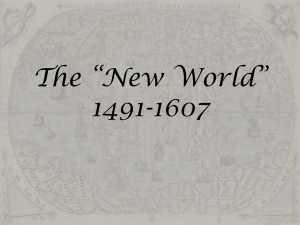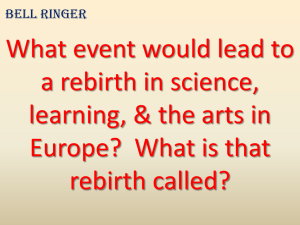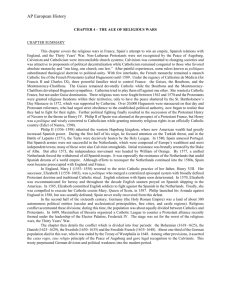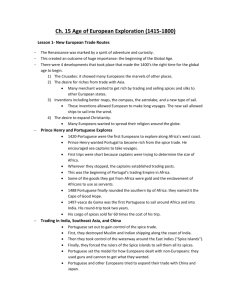Ch 3
advertisement
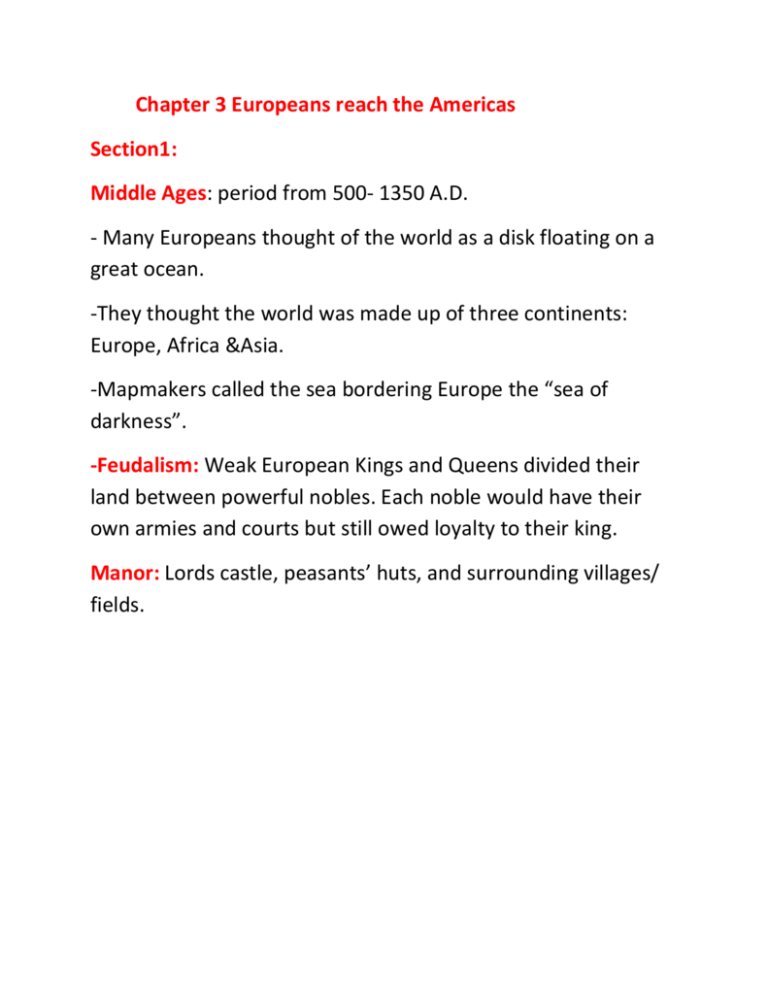
Chapter 3 Europeans reach the Americas Section1: Middle Ages: period from 500- 1350 A.D. - Many Europeans thought of the world as a disk floating on a great ocean. -They thought the world was made up of three continents: Europe, Africa &Asia. -Mapmakers called the sea bordering Europe the “sea of darkness”. -Feudalism: Weak European Kings and Queens divided their land between powerful nobles. Each noble would have their own armies and courts but still owed loyalty to their king. Manor: Lords castle, peasants’ huts, and surrounding villages/ fields. -Most people on the manor were serfs and bound to the land for life or could not leave the land without the lord’s permission. Manors produced nearly everything, even a place to worship were serfs and lords heard teaching of the Roman Catholic Church. Crusades: Western Europe: Roman Catholic, they referred to the Middle East as the holy land, as well as the Muslims. The Roman Catholic Church fought a series of religious wars to gain control of the holy land from Turkish Muslims. Effects of the crusades: large numbers of Europeans traveled beyond their small towns. Arab traders now traded with Asia and new food became part of the Middle Eastern diet. Arabs taught the Italians how to navigate the Mediterranean Sea by using the magnetic compass. Renaissance: (rebirth) burst of learning from Europeans making discoveries in medicine, astronomy and chemistry. Printing press: invented in the mid 1400’s by Johannes Guttenberg of Germany. The invention of the press allowed large numbers of books to be printed at a low cost. More people learned to read and learn about the world. -New rulers looked for ways to increase their wealth; France, Portugal and Spain wanted to trade with China and other Asian countries to make a profit. However the Arab & Italian merchants controlled the Mediterranean Sea. Portuguese slave trade: in 1441 the Portuguese raided an African village; they captured a dozen Africans and sold them as slaves. Trading along the West African coast marked the turning point in slavery. Soon 11 million Africans will be enslaved. Christopher Columbus: set sail August 1492 with 3 vessels and a crew of 90 men. He commanded the largest ship, the Santa Maria. The other ships were the Nina and the Pinta. On October 12 he planted the banner of Spain in what he believed to be the West Indies, he called the people Indians. He brought back pearls and parrots to King Ferdinand and Queen Isabella of Spain. They agreed to finance future voyages. Christopher Columbus (1451-1506) made four voyages to the New World. 1) 1492-1493 : Bahamas, Hispaniola, and Cuba 2) 1493-1494 : Hispaniola, Cuba, and Jamaica 3) 1498 : Trinidad and Venezuela 4) 1502-1504 : Honduras, Nicaragua, Panama, marooned on Jamaica for a year (tropical storms and then ship worms destroyed his ships) - People of Hispaniola complained of Columbus’s harsh rule, when Queen Isabella went there to investigate, they sent Columbus back to Spain in chains. Isabella pardoned Columbus, he died in 1506 still convinced he had reached Asia. Section 2: Conquistadors: “conquerors” came to the Americas in search for glory and gold who made Spain one of the richest empires in Europe. By 1511 the Spanish had conquered Puerto Rico, Jamaica, and Cuba. Ferdinand Magellan: sailed across the Pacific from Spain in 1519. Magellan was later killed by Philippine people off the coast of Asia. Out of 250 crew members, only 18 returned back to Spain in 1522.Their voyage around the world made Europeans aware of the size of the earth. Hernando Cortez : November 8, 1519 Spanish leader marched into the Aztecs capital Tenochtitlan, held their leader Montezuma captive for 6 months. The Aztecs drove out the Spanish but Cortez soon returned with help and captured and destroyed most of Tenochtitlan. The Aztec Empire had fallen. Francisco Pizarro: invaded/ captured the Incan empire. By 1535 he controlled much of the empire. How did the Spanish conquer great empires? 1st: Spanish fought w/ iron swords, guns and cannons and the Native Americans fought with bows, arrows and spears. 2nd: the Aztecs/ Incas had never seen horses. 3rd: they had no resistance to Spanish diseases. Many died from chickenpox, measles &influenza. Juan Ponce de Leon: traveled through parts of Florida in1513 looking for the fountain of youth. Hernando De Soto: arrived in Florida in 1539 looking for gold/ treasure. Panfilo de Narvaez: landed in Florida and unwisely attacked the Native Americans for their food, they struck back and he was then blown off course in his boat never to be seen again. Only 4 men from the expedition survived. Laws of the Indies: Set up laws how colonies should be organized. -3 settlements in New Spain were allowed: Pueblos, Presidios and Missions. Missions: religious settlements run by a Catholic priest and friars. The Spanish believed they had a duty to convert Indians to the Catholic religion. Class System: Peninsulares: Born in Spain and sent by the Spanish gov. to rule the colonies. Creoles: people born in America with Spanish parents Mestizos: people of mixed Spanish and Indian background Encomiedas: The government gave Settlers that came to New Spain the right to demand labor or taxes from Native Americans living on the land. Section 3: Staking Claims in North America John Cabot: reached a “new-found” land he thought was Asia. In fact, it was North America. It is now called Newfoundland and is in the most eastern province of Canada. Giovanni de Verrazano: an Italian captain who sailed for the French in 1524, he journeyed along the North American coast from the Carolinas to Canada. Jaques Cartier: Claimed the land in North America and named it Canada (taken from an Iroquois name Kanata.) Henry Hudson: Sailed for the Dutch in 1609, his ship named Half Moon entered todays NY harbor and continued 150 miles up the river that now bears his name. He then spent the following year on a voyage far north spending a winter in the Hudson Bay. His sailors rebelled and put Hudson, his son and 7 sailors on a small boat. They were never seen again. Martin Luther: A German Monk, he challenged many practices of the Catholic Church. He believed the church had become too greedy and worldly. He also objected that believers had to perform good works in order to be granted eternal life and people could only be saved by their faith in God. His supporters became known as Protestants. Protestant Reformation: “Faith alone” movement that divided Christian in Europe. Samuel de Champlain: sailor/ mapmaker. He promoted French Fur trade and founded settlements known as New France. It took port at Port Royal, Nova Scotia in 1605. He built a trading post known as Quebec. -Most French colonist were trappers &traders because they lived in the woods and learned how to survive from Native Americans. -Catholic Missionaries traveled with trappers and were determined to convert Native Americans. Section 4: Richard Hakluyt: Wrote a pamphlet convincing Queen Elizabeth I of England to set up colonies in North America. In 1585 7 ships and 100 men set out across the Atlantic. They landed on present day North Carolina and within a year sailed back to England because colonists quarreled with neighboring Indians. 2nd Attempt: colonists came with women, when supplies ran low, one settler sailed back and left behind 117 people. It was 3 years before he ever could come back. Virginia Company of London: received a charted (legal document) giving them the right to settle in North America. In 1607 105 colonists arrived in Virginia. They named their tiny outpost Jamestown. -the Virginia Company chose 13 men to rule the settlement. Captain John Smith: saved the Jamestown settlement he began to trade with Indian villages. The economy in Jamestown improved when colonists began to grow tobacco. Soon England was importing 30,000 pounds of tobacco a year; they had found a way to make money. -In 1619 a Dutch ship landed in Jamestown with 20 Africans. The Dutch sold them to the Virginians who needed them for labor. By 1644 300 Africans lived in Virginia, some free planters. Early 1600’s Africans could own land, vote and testify in court. House of Burgesses: representatives chosen to meet in an assembly and together with the governor they set laws for the colony. This marked the beginning of the representative government. Magna Carta: “Great Charter” said the king could not raise taxes without first consulting the Great Council of nobles and church leaders. (This soon grew in to what we know as parliament) Women in Virginia: leaders soon realized if Jamestown were to last it needed more families. In 1619 investors send 100 women to Jamestown each man who married one of these women had to give the Virginia Company 150 pounds of tobacco. Pilgrims: English settlers who sought to practice their own religion freely. They belonged to a group called seperatests.






